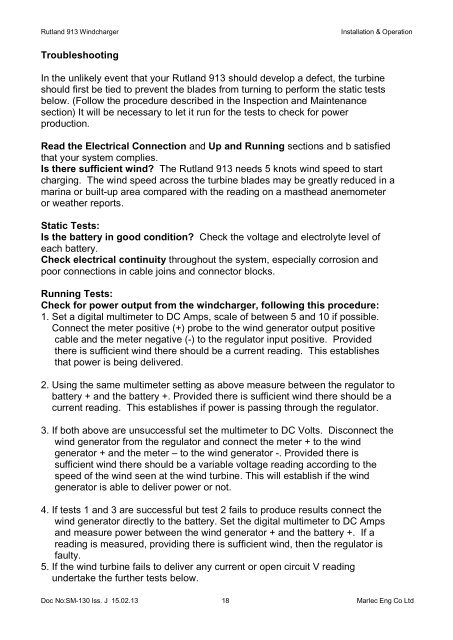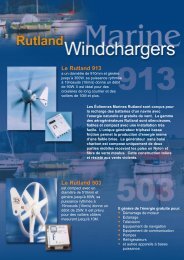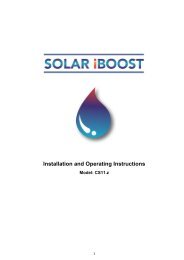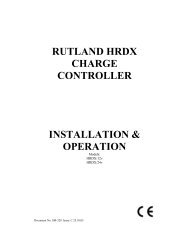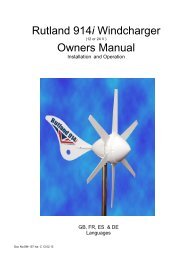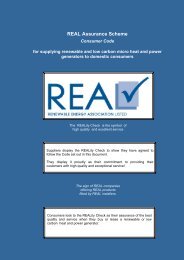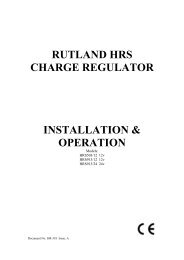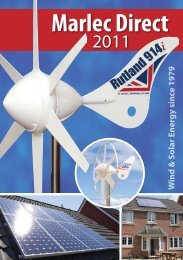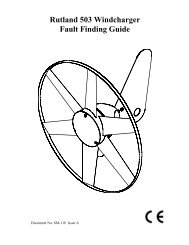Rutland 913 Windcharger Owners Manual - Marlec Engineering Co ...
Rutland 913 Windcharger Owners Manual - Marlec Engineering Co ...
Rutland 913 Windcharger Owners Manual - Marlec Engineering Co ...
Create successful ePaper yourself
Turn your PDF publications into a flip-book with our unique Google optimized e-Paper software.
<strong>Rutland</strong> <strong>913</strong> <strong>Windcharger</strong><br />
Installation & Operation<br />
Troubleshooting<br />
In the unlikely event that your <strong>Rutland</strong> <strong>913</strong> should develop a defect, the turbine<br />
should first be tied to prevent the blades from turning to perform the static tests<br />
below. (Follow the procedure described in the Inspection and Maintenance<br />
section) It will be necessary to let it run for the tests to check for power<br />
production.<br />
Read the Electrical <strong>Co</strong>nnection and Up and Running sections and b satisfied<br />
that your system complies.<br />
Is there sufficient wind The <strong>Rutland</strong> <strong>913</strong> needs 5 knots wind speed to start<br />
charging. The wind speed across the turbine blades may be greatly reduced in a<br />
marina or built-up area compared with the reading on a masthead anemometer<br />
or weather reports.<br />
Static Tests:<br />
Is the battery in good condition Check the voltage and electrolyte level of<br />
each battery.<br />
Check electrical continuity throughout the system, especially corrosion and<br />
poor connections in cable joins and connector blocks.<br />
Running Tests:<br />
Check for power output from the windcharger, following this procedure:<br />
1. Set a digital multimeter to DC Amps, scale of between 5 and 10 if possible.<br />
<strong>Co</strong>nnect the meter positive (+) probe to the wind generator output positive<br />
cable and the meter negative (-) to the regulator input positive. Provided<br />
there is sufficient wind there should be a current reading. This establishes<br />
that power is being delivered.<br />
2. Using the same multimeter setting as above measure between the regulator to<br />
battery + and the battery +. Provided there is sufficient wind there should be a<br />
current reading. This establishes if power is passing through the regulator.<br />
3. If both above are unsuccessful set the multimeter to DC Volts. Disconnect the<br />
wind generator from the regulator and connect the meter + to the wind<br />
generator + and the meter – to the wind generator -. Provided there is<br />
sufficient wind there should be a variable voltage reading according to the<br />
speed of the wind seen at the wind turbine. This will establish if the wind<br />
generator is able to deliver power or not.<br />
4. If tests 1 and 3 are successful but test 2 fails to produce results connect the<br />
wind generator directly to the battery. Set the digital multimeter to DC Amps<br />
and measure power between the wind generator + and the battery +. If a<br />
reading is measured, providing there is sufficient wind, then the regulator is<br />
faulty.<br />
5. If the wind turbine fails to deliver any current or open circuit V reading<br />
undertake the further tests below.<br />
Doc No:SM-130 Iss. J 15.02.13 18 <strong>Marlec</strong> Eng <strong>Co</strong> Ltd


